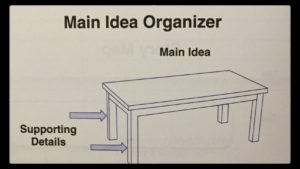
Whether referred to as concept, mind, or semantic maps or as word webs, graphic organizers are one of the best friends of a teacher who desires to facilitate the comprehension of students’ brains, so they are beneficial to all. The students strong in left hemisphere can supply the verbiage, and the right-hemisphere students have the option of showing what they know pictorially. Having students draw the organizer along with you as you explain the major concepts and details facilitates memory.
What The Research Says
Graphic organizers can help students organize and use information by processing random thoughts and pulling them together (Gregory & Chapman 2013).
Graphic organizers make abstract ideas more visible and concrete and can make connections between a student’s prior knowledge, what they are learning today, and what they can apply to future learning (Burke, 2009).
Concept maps help students synthesize and recognize major themes, ideas, and interrelationships, especially for those students who do not possess organizing and synthesizing skills (Hattie, 2009).
Make It Happen
- To access students’ prior knowledge and summarize content after a lesson is taught, have students complete a K-N-L graphic organizer. Have students discuss or brainstorm (1) what they already know about a concept or unit of study; (2) what they will need to know to comprehend the concept, and (3) following instruction, what they have
- Because the brain thinks in chunks or connections, have students increase their knowledge of vocabulary by using a word web. As new vocabulary is introduced, have students complete a word web by brainstorming additional synonyms for the new word. Students can keep their word webs in a notebook for review and add synonyms throughout the year. Encourage them to add these words to their speaking and writing vocabularies as well.
- To help students identify the main idea and details in narrative or content-area texts, use the simile that a main idea and details are like a table top and legs. Draw a table with legs like the one below and have students write the main idea on the top of the table and one supporting detail on each leg

For more examples of instructional activities that engage students using graphic organizers, semantic maps, and word webs, consult the 3rd edition of my best-selling book, Worksheets Don’t Grow Dendrites.